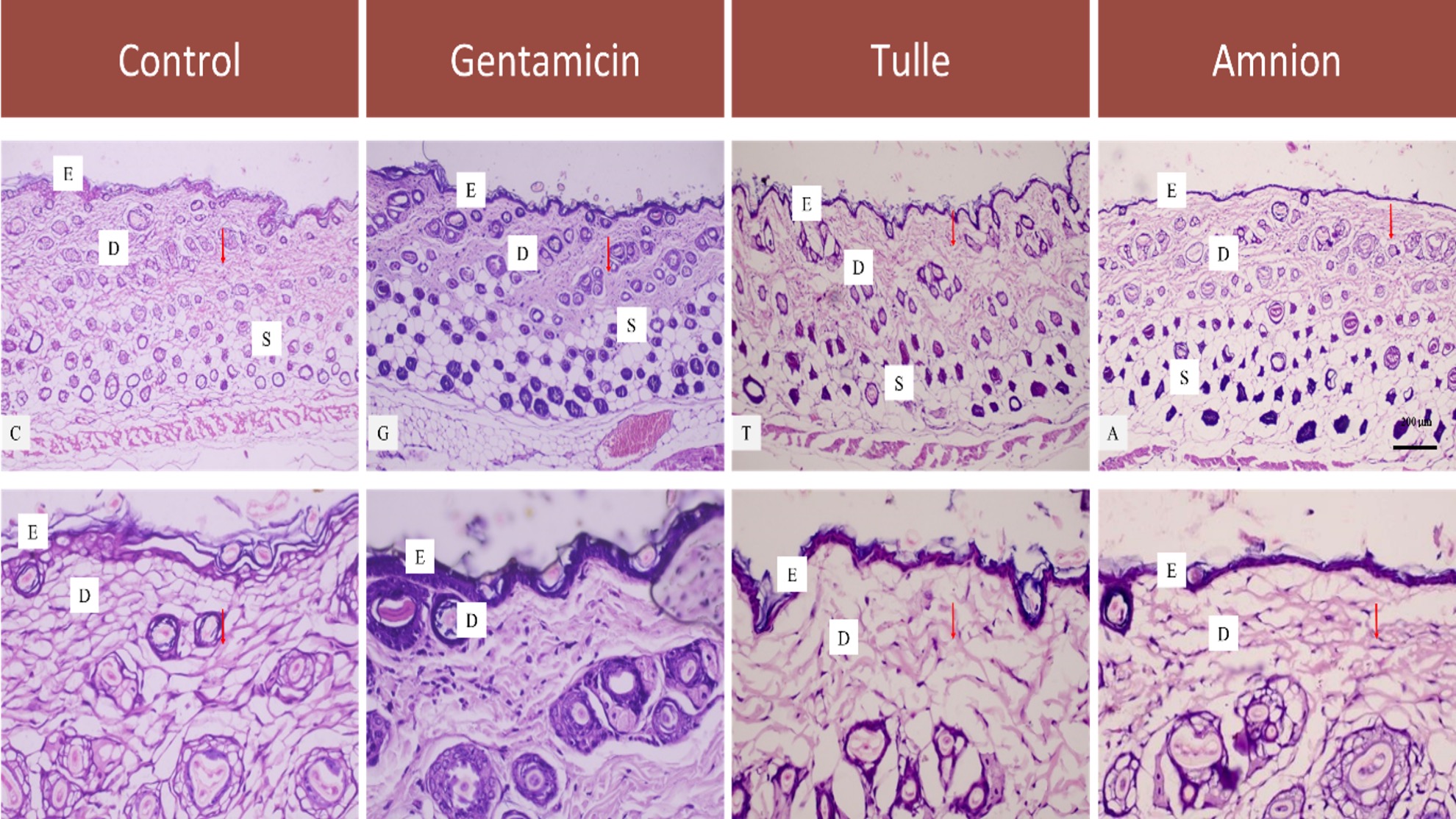Histological Comparison of Lyophilized Amniotic Membrane, Tulle Gras Dressing and Topical Gentamicin on Acute Partial Thickness Wound : In Vivo Study
Main Article Content
Abstract
Background: Partial thickness wounds refer to the damage that extends from the epidermis to the upper layers of dermis. This study aims to compare the histological regrowth of acute partial thickness wounds following application of lyophilized amniotic membrane, tulle grass dressing and topical gentamicin. This study aims to establish a standard approach for treating partial thickness wound.
Methods: Three groups of Mus Musculus mice were used in our experimental study. Similar to harvesting split thickness skin grafts, partial thickness wounds are performed. The wound was then treated with lyophilized amniotic membrane, tulle grass dressing and topical gentamicin. Using the Scoring System for Histological Assessment of Wound Healing, the wound is histopathologically examined at day 14. In this study, One way Anova was used for statistical analysis.
Results: Application of lyophilized amniotic membrane showed different histological characteristic of healing from other method, with p=0.001 it showed significance epidermal growth compared to topical gentamicin. Whereas dermal thickness were also better, accompanied by lower dermal collagen density. Amniotic membrane has a large source of stem cells and contains several growth factors which is important in the physiological process of wound healing and tissue regeneration.
Conclusions: Characteristic of skin healing using lyophilized amniotic membrane showed rapid epidermal growth and gave impression of less fibrosis tissue, so that would be potential for better wound treatment especially for prevention of scar.
Article Details

This work is licensed under a Creative Commons Attribution 4.0 International License.
How to Cite
References
Takeo M, Lee W, Ito M. Wound healing and skin regeneration. Cold Spring Harb. Perspect Med. 2015;5: a023267.
Naik S et al. Commensal–dendritic-cell interaction specifies a unique protective skin immune signature. Nature. 2015; 520: 104–108.
Wilkinson HN, Hardman MJ. Wound healing: cellular mechanisms and pathological outcomes. Open Biol. 2020; 10: 200223.
Shrestha R, Krishan K, Kanchan T. Abrasion. [Updated 2022 Aug 1]. In: StatPearls [Internet]. Treasure Island (FL): StatPearls Publishing; 2022 Jan. Available from: https://www.ncbi.nlm.nih.gov/books/NBK554465/
Kepel FR, Mallo JF & Tomuka D. Pola Luka pada Kasus Kecelakaan Lalu Lintas di Bagian Ilmu Kedokteran Forensik dan Medikolegal RSUP Prof. Dr. R. D Kandou Manado Periode Tahun 2017. Jurnal Biomedik (JBM). 2019;11(1)23-28
Sharma S, Kumari K, Makhni R. Tattoo Removal using Surgical Techniques: Experience with 350 Cases. Int J Sci Stud 2019;6(11):123- 129.
Shahid S, Khan AR, Rahman M, Lina K. Effectiveness of Radiation Sterilized Amniotic Membrane in Reducing Patient’s Morbidity In Comparison To Non-Biological Dressing Like Medicated Tulle (Sofra-Tulle)”. IOSR Journal of Dental and Medical Sciences (IOSR-JDMS). 2019; 18 (1- 18): 44- 50.
Wang P, Long Z, Yu Z, et al. The efficacy of topical gentamycin application on prophylaxis and treatment of wound infection: A systematic review and meta-analysis. Int J Clin Pract. 2019;73:e13334.
Sandora N, Fitria NA, Kusuma TR, Winarno GA, Tanjunga SF, Wardhana A. Amnion bilayer for dressing and graft replacement for delayed grafting of full-thickness burns; A study in a rat model. PloS ONE. 2022; 17(1): e0262007.
Schmiedova I, Dembickaja A, Kiselakova L, Nowakova B, Slama P. Using of Amniotic Membrane Derivatives for the Treatment of Chronic Wounds. Membranes (Basel). 2021;11(12):941.
Laranjo, Mafalda. Preservation of Amniotic Membrane. Amniotic Membrane: Origin Characterization and Medical Applications. 2015;13:209-230.
Kannaiyan J, et al. Amniotic membrane as a scaffold in wound healing and diabetic foot ulcers: an experimental technique and recommendations. Int J Res Med Sci 2016;4: 3654-60.
ElHeneidy H, et al. The amniotic membrane can be a valid source for wound healing. International Journal of Women's Health. 2016;8: 225–231.
Aragona, M., Dekoninck, S., Rulands, S., Lenglez, S., Mascre, G., Simons, B. D., et al. Defining stem cell dynamics and migration during wound healing in mouse skin epidermis. Nat Commun. 2017; 8:14684.
Ruiz-Cañada Catalina, Bernabé-García Ángel, Liarte Sergio, Rodríguez- Valiente Mónica, Nicolás Francisco José. Chronic Wound Healing by Amniotic Membrane: TGF-ÿ and EGF Signaling Modulation in Re-epithelialization. Frontiers in Bioengineering and Biotechnology. 2021;9.
Castellanos, G., Bernabe-Garcia, A., Moraleda, J.M., and Nicolas, F.J. Amniotic membrane application for the healing of chronic wounds and ulcers. Placenta. 2017; 59: 146–153.
Koob TJ, Rennert R, Zabek N, et al. Biological properties of dehydrated human amnion/chorion composite graft: implications for chronic wound healing. Int Wound J. 2013;10(5):493-500.
Murphy SV, Skardal A, Song L, Sutton K, Haug R, Mack DL, et al. Solubilized amnion membrane hyaluronic acid hydrogel accelerates full-thickness wound healing. Stem Cells Transl. Med. 2017; 6: 2020–2032.
Ruiz-Canada C, Bernabe-Garcia A, Liarte S, Insausti CL, Angosto D, Moraleda JM, et al. The amniotic membrane stimulates cell migration by modulating transforming growth factor-beta signaling. J Tissue Eng Regen Med. 2017; 12, 808–820.
Rousselle P, Braye F, and Dayan G. Re-epithelialization of adult skin wounds: cellular mechanisms and therapeutic strategies. Adv Drug Deliv Rev. 2019; 146, 344–365.
